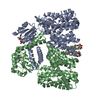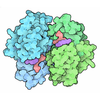+ Open data
Open data
- Basic information
Basic information
| Entry | Database: PDB / ID: 8by2 | |||||||||
|---|---|---|---|---|---|---|---|---|---|---|
| Title | Structure of the K+/H+ exchanger KefC with GSH. | |||||||||
 Components Components | Glutathione-regulated potassium-efflux system protein KefC | |||||||||
 Keywords Keywords |  MEMBRANE PROTEIN / potassium proton exchanger / KefC / MEMBRANE PROTEIN / potassium proton exchanger / KefC /  Transporter / CPA / GSH Transporter / CPA / GSH | |||||||||
| Function / homology |  Function and homology information Function and homology informationglutathione-regulated potassium exporter activity / response to methylglyoxal /  antiporter activity / antiporter activity /  toxic substance binding / proton transmembrane transport / toxic substance binding / proton transmembrane transport /  enzyme binding / enzyme binding /  plasma membrane plasma membraneSimilarity search - Function | |||||||||
| Biological species |   Escherichia coli (E. coli) Escherichia coli (E. coli) | |||||||||
| Method |  ELECTRON MICROSCOPY / ELECTRON MICROSCOPY /  single particle reconstruction / single particle reconstruction /  cryo EM / Resolution: 3.18 Å cryo EM / Resolution: 3.18 Å | |||||||||
 Authors Authors | Gulati, A. / Drew, D. | |||||||||
| Funding support | European Union,  Sweden, 2items Sweden, 2items
| |||||||||
 Citation Citation |  Journal: To be published Journal: To be publishedTitle: Structure and mechanism of the K+/H+ exchanger KefC Authors: Gulati, A. / Drew, D. | |||||||||
| History |
|
- Structure visualization
Structure visualization
| Structure viewer | Molecule:  Molmil Molmil Jmol/JSmol Jmol/JSmol |
|---|
- Downloads & links
Downloads & links
- Download
Download
| PDBx/mmCIF format |  8by2.cif.gz 8by2.cif.gz | 520.4 KB | Display |  PDBx/mmCIF format PDBx/mmCIF format |
|---|---|---|---|---|
| PDB format |  pdb8by2.ent.gz pdb8by2.ent.gz | 346.8 KB | Display |  PDB format PDB format |
| PDBx/mmJSON format |  8by2.json.gz 8by2.json.gz | Tree view |  PDBx/mmJSON format PDBx/mmJSON format | |
| Others |  Other downloads Other downloads |
-Validation report
| Arichive directory |  https://data.pdbj.org/pub/pdb/validation_reports/by/8by2 https://data.pdbj.org/pub/pdb/validation_reports/by/8by2 ftp://data.pdbj.org/pub/pdb/validation_reports/by/8by2 ftp://data.pdbj.org/pub/pdb/validation_reports/by/8by2 | HTTPS FTP |
|---|
-Related structure data
| Related structure data |  16319MC  8bxgC C: citing same article ( M: map data used to model this data |
|---|---|
| Similar structure data | Similarity search - Function & homology  F&H Search F&H Search |
- Links
Links
- Assembly
Assembly
| Deposited unit | 
|
|---|---|
| 1 |
|
- Components
Components
| #1: Protein | Mass: 61183.223 Da / Num. of mol.: 2 Source method: isolated from a genetically manipulated source Source: (gene. exp.)   Escherichia coli (E. coli) Escherichia coli (E. coli)Gene: kefC, kefC_3, kefC_4, A9X72_21045, ACU57_16285, AT845_001330, BHS81_26455, BJJ90_21970, BLM69_001595, BMT91_01970, BN17_44701, BON64_08355, BON68_06240, BON72_08730, BON76_14820, BON94_26490, ...Gene: kefC, kefC_3, kefC_4, A9X72_21045, ACU57_16285, AT845_001330, BHS81_26455, BJJ90_21970, BLM69_001595, BMT91_01970, BN17_44701, BON64_08355, BON68_06240, BON72_08730, BON76_14820, BON94_26490, BON97_15340, BRV02_001703, BTQ06_18350, BvCmsF30A_01124, BvCmsHHP056_04946, BvCmsKKP061_01751, BvCmsKSNP073_00849, BVL39_02825, C0P57_001700, C1Q91_003817, CCS08_23225, CIG67_13365, CR538_21280, CV83915_01528, CWS33_08975, D3Y67_20250, D9H94_05730, DAH19_13555, DAH22_04310, DAH27_12485, DAH28_04320, DAH29_14050, DAH30_11255, DAH32_09665, DAH37_05870, DAH41_08355, DEN89_19705, DEN90_18045, DEN96_05545, DEN97_05070, DEN98_05075, DEN99_02470, DEO00_04545, DEO12_14740, DEO14_11885, DEO19_04855, DIV22_05610, DRW19_05570, DS732_05130, DTL43_06565, DXT69_02135, DXT71_01260, E2121_11235, E2122_03850, E2127_05310, E2128_11280, E2129_03465, E2131_02880, E2132_05315, E2135_03750, E5P26_16110, E5P27_07520, E5P28_15370, E5P29_09025, E5P30_07860, E5P39_14645, E5P41_09555, E5P42_00460, E5P43_10360, E5P44_10710, E5P45_09675, E5P46_12140, E5P47_12165, E5P48_11095, E5P49_12390, E5P50_01615, E5P51_19605, E5S35_00760, E5S38_08180, E5S42_10720, E5S43_02390, E5S45_05455, E5S52_10125, E6D34_01595, EAI46_08450, EBP16_09705, EC95NR1_04226, EHD79_22595, EKI52_11150, EL79_3823, EL80_3769, ELT21_05100, ELV08_16095, ELY39_00725, ERS139208_01108, F0L67_09735, FDM60_06480, FJQ40_06620, FPJ29_04385, G3V95_03045, G4A38_11120, G4A47_11350, GAI66_03965, GF699_05360, GNZ05_10415, GOP25_07850, GP944_03730, GP965_24280, GQM04_06640, GRW24_15515, GUC01_17280, HNC36_14075, HV209_00940, J5U05_003215, JFD_01135, JNP96_04415, NCTC10865_05215, NCTC8960_01687, NCTC9036_04147, SAMEA3753106_01628, WR15_01725 Production host:   Escherichia coli (E. coli) / References: UniProt: J7Q5Y6 Escherichia coli (E. coli) / References: UniProt: J7Q5Y6#2: Chemical | #3: Chemical |  Adenosine monophosphate Adenosine monophosphate#4: Chemical |  Glutathione Glutathione#5: Chemical |  Phosphatidylglycerol PhosphatidylglycerolHas ligand of interest | Y | |
|---|
-Experimental details
-Experiment
| Experiment | Method:  ELECTRON MICROSCOPY ELECTRON MICROSCOPY |
|---|---|
| EM experiment | Aggregation state: PARTICLE / 3D reconstruction method:  single particle reconstruction single particle reconstruction |
- Sample preparation
Sample preparation
| Component | Name: Kefc protein dimer with GSH / Type: COMPLEX / Entity ID: #1 / Source: RECOMBINANT |
|---|---|
| Molecular weight | Experimental value: NO |
| Source (natural) | Organism:   Escherichia coli (E. coli) Escherichia coli (E. coli) |
| Source (recombinant) | Organism:   Escherichia coli (E. coli) Escherichia coli (E. coli) |
| Buffer solution | pH: 7.5 |
| Specimen | Embedding applied: NO / Shadowing applied: NO / Staining applied : NO / Vitrification applied : NO / Vitrification applied : YES : YES |
Vitrification | Instrument: FEI VITROBOT MARK IV / Cryogen name: ETHANE / Humidity: 100 % |
- Electron microscopy imaging
Electron microscopy imaging
| Experimental equipment |  Model: Titan Krios / Image courtesy: FEI Company |
|---|---|
| Microscopy | Model: FEI TITAN KRIOS |
| Electron gun | Electron source : :  FIELD EMISSION GUN / Accelerating voltage: 300 kV / Illumination mode: FLOOD BEAM FIELD EMISSION GUN / Accelerating voltage: 300 kV / Illumination mode: FLOOD BEAM |
| Electron lens | Mode: BRIGHT FIELD Bright-field microscopy / Nominal magnification: 130000 X / Nominal defocus max: 2000 nm / Nominal defocus min: 600 nm / C2 aperture diameter: 50 µm Bright-field microscopy / Nominal magnification: 130000 X / Nominal defocus max: 2000 nm / Nominal defocus min: 600 nm / C2 aperture diameter: 50 µm |
| Image recording | Electron dose: 64.3 e/Å2 / Film or detector model: GATAN K3 BIOQUANTUM (6k x 4k) |
- Processing
Processing
CTF correction | Type: PHASE FLIPPING AND AMPLITUDE CORRECTION | ||||||||||||||||||||||||
|---|---|---|---|---|---|---|---|---|---|---|---|---|---|---|---|---|---|---|---|---|---|---|---|---|---|
| Symmetry | Point symmetry : C1 (asymmetric) : C1 (asymmetric) | ||||||||||||||||||||||||
3D reconstruction | Resolution: 3.18 Å / Resolution method: FSC 0.143 CUT-OFF / Num. of particles: 260115 / Symmetry type: POINT | ||||||||||||||||||||||||
| Refinement | Cross valid method: NONE Stereochemistry target values: GeoStd + Monomer Library + CDL v1.2 | ||||||||||||||||||||||||
| Displacement parameters | Biso mean: 82.62 Å2 | ||||||||||||||||||||||||
| Refine LS restraints |
|
 Movie
Movie Controller
Controller




 PDBj
PDBj















